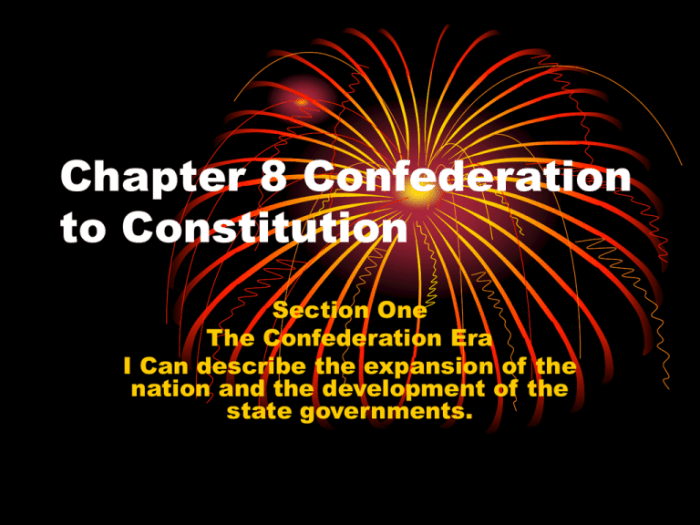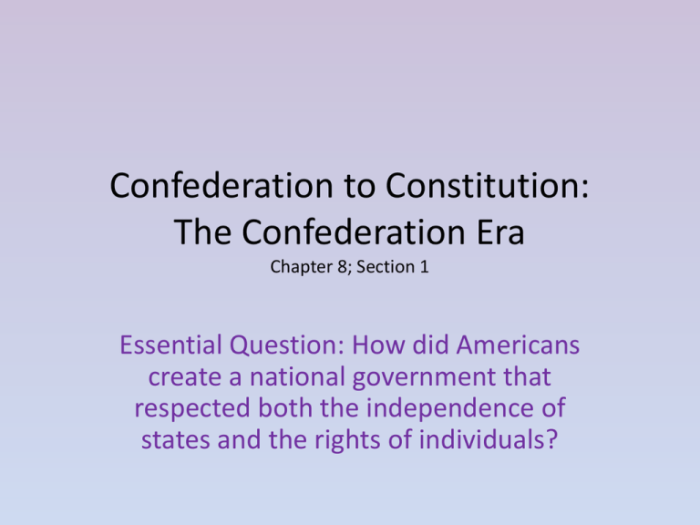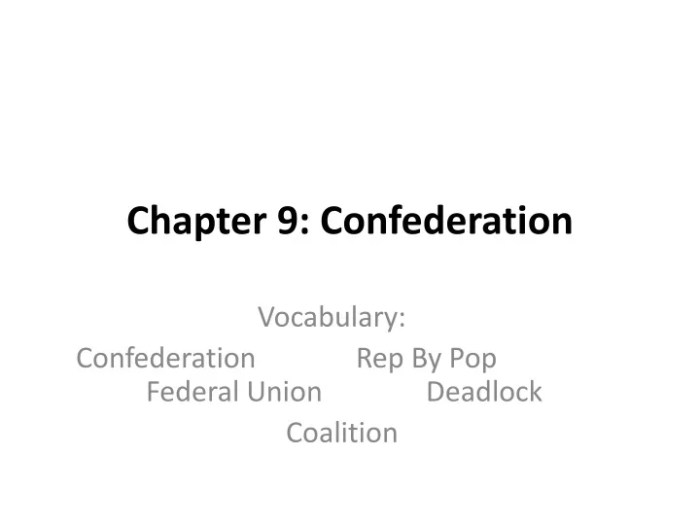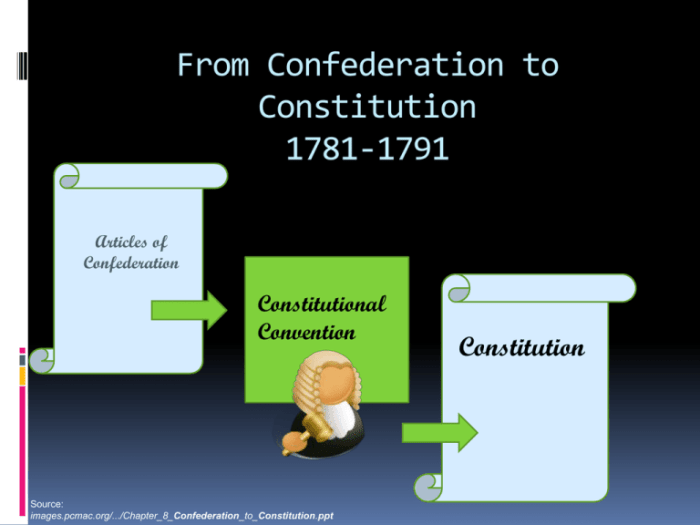Chapter 9 the confederation and the constitution – Chapter 9: The Confederation and the Constitution delves into the historical context and significance of these foundational documents, exploring their impact on the development of American democracy and governance. This chapter analyzes the weaknesses of the Articles of Confederation, the challenges faced by the Continental Congress, and the purpose and key debates of the Constitutional Convention.
Furthermore, it examines the structure and principles enshrined in the Constitution, including federalism, separation of powers, and checks and balances. The chapter also discusses the impact of the Constitution on American society, its role in shaping the nation’s political system, economy, and social fabric, and its influence on key events and decisions in American history.
1. Historical Context of the Confederation
The Articles of Confederation, ratified in 1781, established the first formal government of the United States. However, it had significant weaknesses that hampered the effectiveness of the national government.
Weaknesses of the Articles of Confederation
- Lack of Executive Authority:The Articles did not create a strong executive branch, making it difficult to enforce laws and coordinate government actions.
- Limited Congressional Powers:Congress lacked the power to tax, regulate commerce, or raise an army, making it dependent on the states for funding and support.
- Unanimous Consent for Amendments:Any amendments to the Articles required unanimous approval from all 13 states, making it nearly impossible to address its shortcomings.
Challenges Faced by the Continental Congress
- Financial Instability:Congress struggled to raise funds due to the lack of taxation authority, leading to unpaid debts and economic instability.
- Foreign Policy Issues:The national government lacked the power to negotiate treaties or respond to foreign threats effectively.
- Internal Conflicts:Disputes between states over trade, land, and other issues weakened the unity of the confederation.
Examples of Limitations
- Congress could not prevent states from issuing their own currency, leading to inflation and economic chaos.
- The inability to raise an army left the country vulnerable to attacks, such as Shays’ Rebellion in Massachusetts.
- The lack of executive authority made it difficult to enforce treaties and protect the rights of American citizens.
2. Constitutional Convention and its Goals

The Constitutional Convention, held in Philadelphia in 1787, was convened to address the weaknesses of the Articles of Confederation and establish a more effective national government.
Purpose of the Convention
- Strengthen the National Government:The delegates sought to create a stronger central government with the authority to address the challenges facing the country.
- Resolve Constitutional Issues:The convention aimed to resolve the ambiguities and limitations of the Articles of Confederation.
- Establish a Framework for Governance:The delegates intended to develop a new constitutional framework that would guide the nation’s future.
Key Figures Involved
- George Washington:Presided over the convention.
- James Madison:Drafted the Virginia Plan, which proposed a strong national government.
- Alexander Hamilton:Advocated for a powerful central government.
- Benjamin Franklin:Played a key role in mediating compromises and securing consensus.
Main Debates and Compromises
- Representation in Congress:The Virginia Plan proposed proportional representation based on population, while the New Jersey Plan called for equal representation for all states.
- Powers of the President:Some delegates favored a strong presidency, while others preferred a more limited role.
- Slavery:The issue of slavery was a major point of contention, eventually resolved by the Three-Fifths Compromise.
3. Structure and Principles of the Constitution

The Constitution of the United States, ratified in 1788, established the framework for the American government and its relationship with the states.
Structure of the Constitution
- Articles:The Constitution is divided into seven articles, each addressing different aspects of government.
- Sections:Each article is further divided into sections, providing more specific details and provisions.
- Amendments:The Constitution has been amended 27 times since its ratification, reflecting changes in society and evolving needs.
Fundamental Principles
- Federalism:The Constitution establishes a federal system, dividing power between the national government and the states.
- Separation of Powers:The Constitution separates the government into three branches: legislative, executive, and judicial, to prevent any one branch from becoming too powerful.
- Checks and Balances:Each branch of government has the ability to check and balance the powers of the other branches, ensuring accountability and preventing tyranny.
Balance of Power
- Congress:Enacts laws, declares war, and has the power to impeach the president.
- President:Executes laws, commands the military, and has the power to veto legislation.
- Supreme Court:Interprets the Constitution, reviews laws, and has the power to declare laws unconstitutional.
4. Impact of the Constitution on American Society

The Constitution has had a profound impact on the development of American democracy, shaping the nation’s political system, economy, and social fabric.
Impact on Democracy
- Rule of Law:The Constitution establishes the principle of rule of law, ensuring that all citizens are subject to the same laws.
- Protection of Rights:The Bill of Rights (the first ten amendments) guarantees fundamental freedoms, such as freedom of speech, religion, and the right to bear arms.
- Representative Government:The Constitution provides for a representative government, where citizens elect officials to represent their interests.
Impact on the Economy, Chapter 9 the confederation and the constitution
- Economic Growth:The Constitution’s protection of property rights and free trade has fostered economic growth and innovation.
- Stable Currency:The Constitution gives Congress the exclusive power to coin money, preventing inflation and ensuring the stability of the currency.
- National Market:The Constitution creates a national market, eliminating trade barriers between states and facilitating economic integration.
Impact on Social Fabric
- Equality before the Law:The Constitution guarantees equal protection under the law for all citizens, regardless of race, gender, or religion.
- National Identity:The Constitution has helped foster a sense of national identity and unity among Americans.
- Social Change:The Constitution has provided a framework for social change through its amendment process, allowing for the expansion of rights and the adaptation to evolving societal values.
5. Historical Interpretations and Debates

The Constitution has been subject to various interpretations and debates throughout history, reflecting the evolving nature of American society and its values.
Historical Interpretations
- Strict Constructionism:Argues that the Constitution should be interpreted narrowly, according to its original intent.
- Loose Constructionism:Allows for a more flexible interpretation of the Constitution, adapting it to changing circumstances.
- Originalism:Emphasizes the importance of the Constitution’s original meaning, as understood by its framers.
Ongoing Debates
- Scope of Federal Power:The extent to which the federal government can exercise power over the states remains a subject of debate.
- Interpretation of the Bill of Rights:The meaning and scope of the rights guaranteed by the Bill of Rights is often contested.
- Role of the Judiciary:The appropriate role of the Supreme Court in interpreting the Constitution is a matter of ongoing debate.
Q&A: Chapter 9 The Confederation And The Constitution
What were the key weaknesses of the Articles of Confederation?
The Articles of Confederation lacked a strong central government, had limited power to tax or regulate commerce, and could not enforce its decisions on the states.
Who were some of the key figures involved in drafting the Constitution?
James Madison, Alexander Hamilton, Benjamin Franklin, and George Washington were among the prominent figures who played a significant role in drafting the Constitution.
What is the principle of federalism?
Federalism divides power between a central government and state governments, with each level having its own distinct responsibilities and authorities.